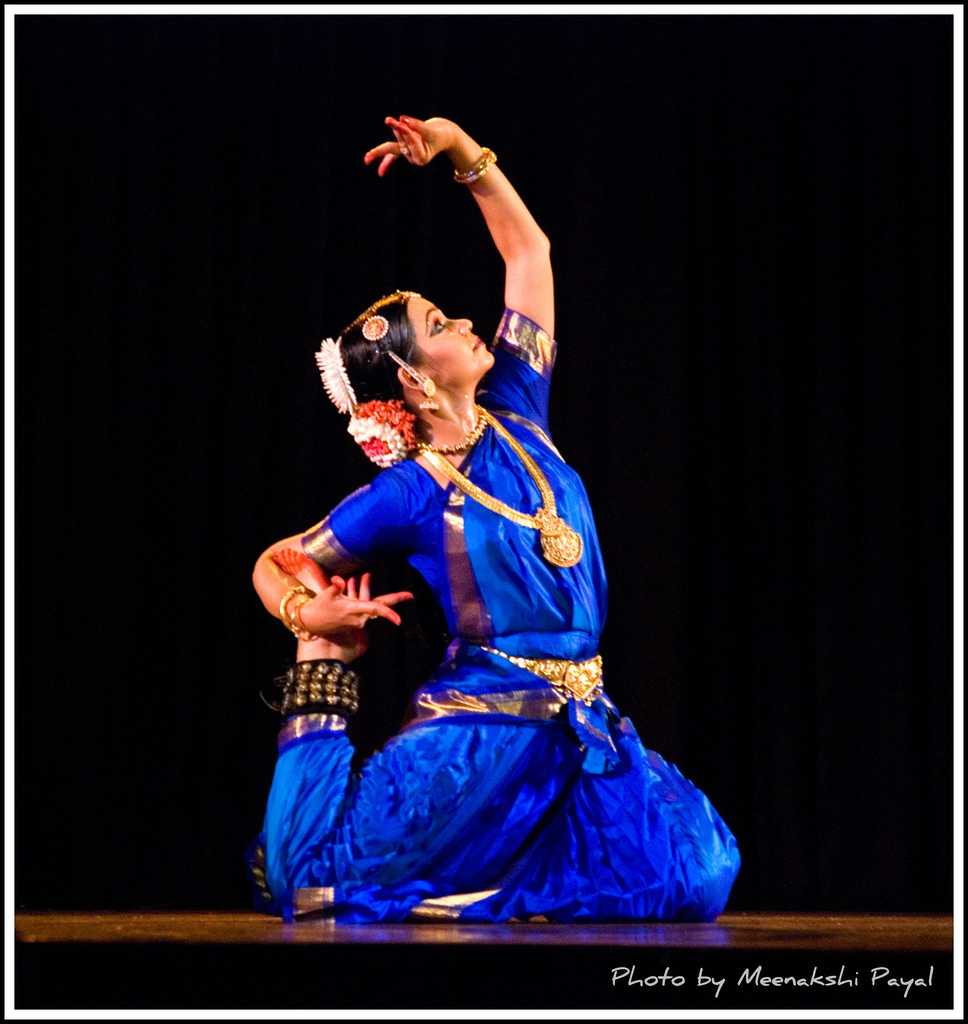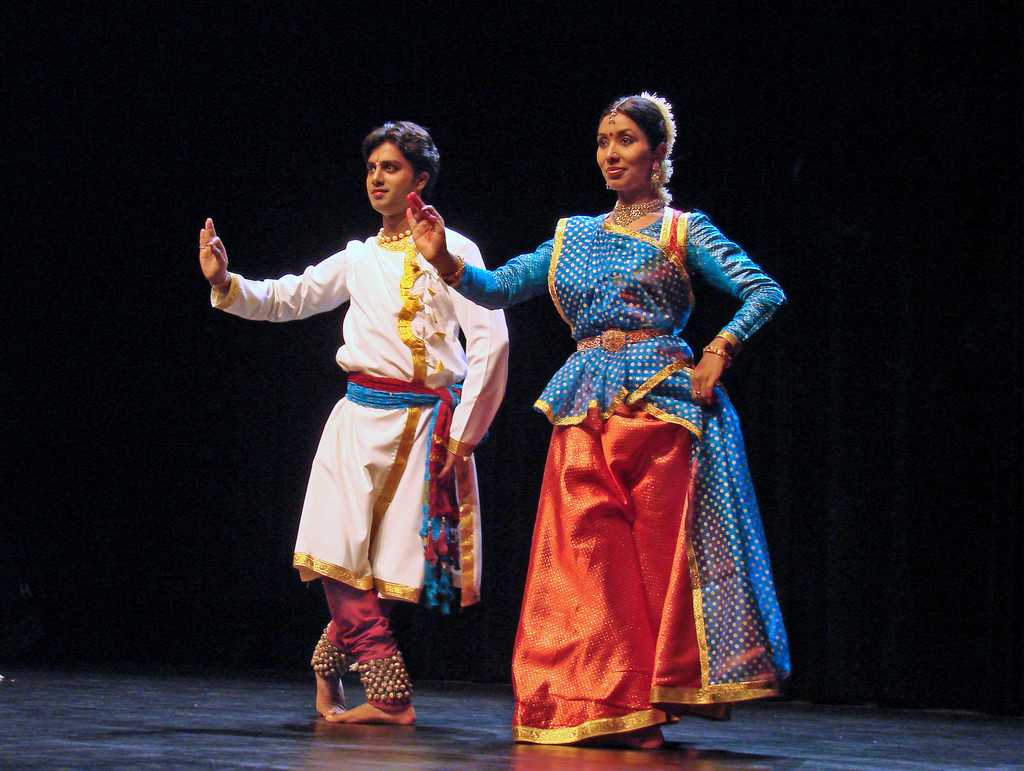School of Indian Dance

The Sangeet Natak Akademi currently confers classical status on eight Indian classical dance styles:
Bharatanatyam
(Tamil Nadu), Kathak (North, West and Central India),Kathakali (Kerala),
Kuchipudi (Andhra),Odissi
(Odisha),
Manipuri
(Manipur), Mohiniyattam (Kerala), and Sattriya (Assam).
For more info go to Wikipedia .
List of Classical & Folk Dance in India

Performed on the celestial tunes of the Carnatic music, Bharatnatyam comes from the state of Tamil
Nadu in
South.
The
origins of Bharatnatyam can be traced back to 1000 BC, and it originates from the ancient temples of
Tamil Nadu
performed by the women of the classical period. The dance form is known for its beautiful body
movements and
gestures
which are called Mudras in the traditional language. It focuses on the hand gestures, leg movement
and the
facial
expressions of the dancer. This dance form was very prevalent before the British era but was
profoundly
depressed
during
the colonial period. However, India kept the dance form alive in the houses, and today it is
recognised as one
of
the
most respectable art forms in India especially in the Southern region of the country where it is a
moment of
pride
for
the women of the house to learn the classical dance form of Bharatnatyam.

Coming from the northern part of the country from the state of Uttar Pradesh, Kathak comes from the
word 'Katha'
which
means "story" in Hindi. It isn't a very smart guess for one to make that Kathak is performed in the
form of
storytelling
through the body movements used by the dancer. Kathak is often referred to as the dance of love, and
it can be
performed
by both by the male and female dancer together. This dance form focuses highly on the ankle
movements
complemented
by
the ankle that has to match the beats of the music. Ankle bells or gunghroos as they are called in
the
traditional
language is an important part of the discipline of this dance form. Various distinctions can be
witnessed in
this
dance
forms as it is performed in various places in the country which includes Jaipur, Benaras, and
Lucknow.

Kathakali is another traditional dance form of India which relates to the storytelling. Kathakali
translates to
the
'storyteller' in the country's language. Coming from the Southern region of the country from Kerala,
Kathakali
is
one of
the most renowned and religious dances forms of India. It originates from the tales of Ramayana and
Shiva
stories.
Kathakali includes the intriguing face movements and the heavy costumes which include the
traditional face masks
and
body paints (generally green). The music which includes only the vocals is called Soppanam. The
storytelling of
the
epic
Hindu mythology tales depicting both evil and good is shown through the conversation between the
dancers only
through
their body gestures and facial expressions. Simply fascinating to watch!

As you stroll towards the North-east India which is brimming with the rich tradition and their
unique culture,
Manipuri
comes as an important symbol to represent the state of Manipur from the region. This dance form is
performed to
narrate
the romantic relationship between the Hindu gods Radha and Krishna, which is famously known as
RaasLeela. This
art
form
is performed in a team with the traditional Manipuri costumes and makeup to narrate the tale of the
two gods.
The
dance
is performed on the narrative chanting and the music created by the Indian classical instruments.

Belonging to the Andhra Pradesh, Kuchipudi is probably the toughest form of classical dance in
India. Kuchipudi
is
not
just considered as the dance but a whole religious procedure dedicated to God which includes certain
rituals
such as
sprinkling the holy water, burning the incense sticks and praying to God. Kuchipudi includes both
singing and
dancing by
the performer which is why it requires both the skill and much more dedication than any other art
forms in
India. In
the
earlier period, Kuchipudi was only performed by the male dancers in the temples, specifically the
Brahmins(
Upper
caste
of the society) but with the passage of time, it became famous amongst the women and nowadays it is
mostly
performed
by
the female dancers.

Odissi dance form comes from the state of Odisha in the eastern part of India. The traditional dance
has been
derived
from the Hindu temples in Odisha. Most of the gestures and movements (Mudras) are inspired by the
sculptors and
idols
belonging to the ancient temples of India. The dance is performed as a way to express the
mythological tales of
Hindu
gods, including that of Shiva and Surya. The dance is accompanied by a mythical story, Hindi poem in
the form of
music
by the musicians. Odissi is considered as the oldest dance forms of India which are surviving till
today. Odissi
dance
is performed mostly by the women dancers, and it includes more than 50 intriguing mudras (body
movements)

Belonging to Punjab, Bhangra is a heart-pumping dance adorned with the loud beats of dhol(
traditional Indian
instrument). It is very prevalent in traditional Punjabi festivals.

Garba comes from Gujarat which is a traditional dance form dedicated to Goddess Durga. It is
performed in a
couple
on
the typical Gujarati music, and the sticks are used to perform this art form.

Performed by the Kashmiri people to celebrate their festivals and important occasions, Rouf is a
soothing dance
form
generally performed by the female dancers on the traditional Kashmiri music.

Wearing heavy jewellery and the beautiful costumes you will find the people of Rajasthan dancing on
the beats of
music
to give away their traditional dance form. Ghoomar includes the intriguing circular movements
complemented by
the
hand
gestures.

The beautiful women dressed in the elegant attire performing the dance form of Chhau is what you see
during the
festival
time in Kolkata. The popular art coming from eastern India is considered as the dance in the form of
martial
arts.

Young men and women mostly perform this joyous folk dance from Assam during the Bihu festival. The
dancers
follow a
pattern of rapid hand movement, quick steps and a rhythmic swaying of hips wearing the traditional
Assamese
clothing
with beautiful accessories. Marking the beginning of spring season, Bihu recites the happiness and
heritage of
Assam
and
is performed on the occasion of Rangali Bihu. The dhol, Xutuli, Toka, Baanhi, Gogona are the instruments
used to
play
the traditional tunes for the performance. The origin of Bihu is not very known, although the records
profoundly
state
that it is originated from the Bisu dance performed by communities of Upper Assam like the Sonowal
Kacharis,
Deoris,
Moran, Chutias and Borahis. The dance form isn't just known in India but globally popular. This popular
Indian
Dance
was
performed at the London Olympics in 2012.

Originated from the state of the Maratha empire, Lavani is a dance form of Maharashtra. The female-oriented
dance is
a
blend of traditional music and tales of deities. The origin of Lavani comes from the word Lavanya which
means
beauty.
Apart from helping in the upliftment of the Marathi folk theatre, the dance form was also a morale booster
during
the
war in the 18th century. Lavani has two forms; One that's philosophical - Nirguni Lavani and the other
that's
sensual-
Shringar Lavani. With the powerful and quick foot-tapping tempo, the dance form is performed along with the
beats of
the
Dholak. The stories or subjects this dance is based on revolves around topics of religion, politics, society
and
mostly
romance. Dancers are dressed in nine-yard of saree with golden jewellery. The dance was initially staged at
local
temples in the form of worship, but now it's a sensual dance performed to the pulsating beats rendering a
socio-political satire.

In Indian mythology, Mohini is the female avatar of Lord Vishnu, and the meaning of Attam in Malayalam is
rhythmic
motion hence adhering to the dance of the divine enchantress. It is the second most popular dance form of
Kerala.
This
classical Indian dance form roots from the age-old Sanskrit text - Natya Shastra. It is traditionally
performed
by
women
following a repertoire of Carnatic music, singing and acting a play. At times, the song, a typical hybrid of
Malayalam
and Sanskrit also called Manipravalam, is sung by the performer herself. With a repertoire of instruments
such a
Mridangam, Madhalam, Flute, Idakka, Veena and Kuzhitalam; the music is rendered in ragas and performed in a
slow
melodic
style. Although the Lasya dance is often portrayed as gentle, graceful and feminine, it also exhibits a
vigorous
dance
of Tandava relating to Lord Shiva. Besides its popularity, the dance was ridiculed by a series of laws as a
devadasi
prostitution system during the colonial British Raj. A ban that was protested repealed in 1940 and with the
help
of
the
locals of Kerala, Mohiniyattam was revived and reconstructed.

Mahapurusha Sankaradeva, a Vaishnava saint and reformer of Assam, introduced Sattriya dance in the 15th
century
AD.
This
dance form was preserved in the Sattras or the Vaishnava Maths; therefore, it remained a living tradition.
This
dance
was an artistic way of presenting mythological teachings. Traditionally this dance was performed by the male
monks
or
bhokots. However, today, the practice has changed in many ways. The theme is not just related to mythology,
and
the
performances are not limited to the Sattras. Even women can perform Sattriya dance and on the stage.
Origin of Indian Dance Forms
Indian dances can be traced back to ancient times. In the cave paintings of Bhimbetka rock shelters in
Madhya
Pradesh,
one can see dancing figures. The sculptures that date back to the Indus Valley Civilization also portray
dancing
figures. The text related to the origin of dance in India can be found in Natya Shastra, which was written
by
the sage
Bharata. This text dates back to the 2nd century AD. In this text, the creation of dance is credited to Lord
Brahma, who
takes its knowledge from the four Vedas.
Other Dance Forms in India & Their States
Andhra Pradesh - Kolattam, Vilasini Natyam, Dhimsa
Arunachal Pradesh - Aji Lamu, Roppi, Phoning
Assam - Bagurumba, Ali Ai Ligang
Bihar - Kajari, Jhumari
Chhattisgarh - Dandari, Gendi, Panthi, Karma, Damkach
Goa - Mando, Talgari, Suvari, Dasarawadan, Kunbi, Fugadi
Gujarat - Raas, Bhavai, Tippani
Haryana - Gugga, Khoria
Himachal Pradesh - Kullu Nati, Namgen, Hikat, Chham
Kashmir - Dumhal, Kud, Bhand Jashan
Jharkhand - Phagua
Karnataka - Krishna Parijatha, Nagamandala, Bhootha Aradhane
Kerala - Kaikottikali, Thumbi Thullal
Madhya Pradesh - Karma, Gaur Maria, Kaksar, Ahiri
Maharashtra - Pavri, Dhangari Gaja
Manipur - Khamba Thoibi, Pung Cholom
Meghalaya - Khuallam, Nongkrem
Mizoram - Cheraw, Khuallam
Nagaland - Changlo-Sua lua
Odisha - Ghumura, Ruk Mar, Goti Pua
Punjab - Jhumar
Rajasthan - Kuccgi ghodi, Kalbelia, Bhavai, Sapera dance
Sikkim - Singhi Cham, Khukuri, Talachi
Tamil Nadu - Karagaattam, Mayil Attam, Kolaattam, Kummi, Kavadi
Tripura - Garia, Hozagiri
Uttar Pradesh - Raaslila, Charkula
Uttarakhand - Barada Nati, Chapeli, Langvir
West Bengal - Gambhira, Kalikapatadi, Domni